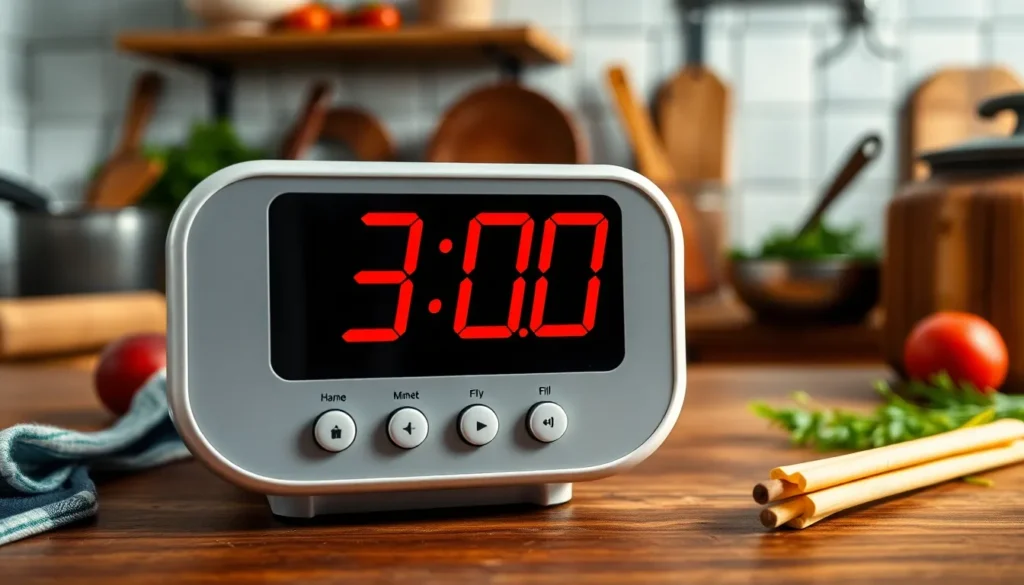When it comes to time, most people think they’ve got it all figured out. But let’s face it—sometimes even the simplest calculations can leave us scratching our heads. Take three minutes, for instance. Sounds easy, right? But how many seconds are we really talking about? If you’ve ever found yourself pondering this question while waiting for your coffee to brew, you’re not alone.
In a world where every second counts, knowing how to convert minutes to seconds can be surprisingly handy. Whether you’re timing a workout, cooking a meal, or just trying to impress your friends with your math skills, this quick calculation can save the day. So buckle up and get ready to uncover the magic number of seconds in three minutes—because who doesn’t want to sound like a time wizard?
Table of Contents
ToggleUnderstanding Time: A Fundamental Concept
Time represents a critical aspect of human existence, making understanding its measurement essential. Calculating time spans accurately enables better planning in daily activities. For example, knowing how to convert minutes into seconds serves practical purposes, especially in scenarios like cooking recipes or workout routines.
Every minute consists of 60 seconds. Therefore, in three minutes, the calculation becomes straightforward. Multiplying the number of minutes by the number of seconds in a minute provides clarity: 3 minutes multiplied by 60 seconds results in 180 seconds. This simple arithmetic showcases why grasping time conversions enhances efficiency.
Grasping time’s significance extends to various fields. In science, precise time measurements impact experiments and project timelines. In education, students benefit from mastering time calculations for assignments and tests. Understanding these conversions helps individuals gauge their productivity and manage schedules effectively.
Individuals can apply their knowledge of time in practical situations. For instance, knowing that 180 seconds equals three minutes allows someone to set timers accurately while cooking. Athletes may use this information to structure their training intervals. Being aware of these conversions fosters confidence in managing time-sensitive tasks.
Breaking Down Minutes and Seconds

Understanding time is vital in daily life. Knowing how many seconds are in three minutes starts with defining a minute.
Definition of a Minute
A minute consists of 60 seconds. This unit of time serves as a fundamental measure, helping individuals plan various activities. Various contexts use minutes, from cooking times to workout durations. Historically, the concept of a minute originated from dividing an hour into smaller, manageable segments. Recognition of a minute’s value aids individuals in making time-sensitive decisions. People might not realize its impact until they experience time constraints in activities.
Definition of a Second
A second is the base unit of time in the International System of Units (SI). Specifically, one minute equals 60 seconds, making seconds crucial for precise timing. Scientists often use seconds for measurements in experiments, ensuring accuracy. Everyday tasks, such as timing a race or cooking, rely on seconds for effective execution. Since a second can feel fleeting, its value becomes apparent in high-pressure situations. Incorporating seconds into calculations enhances efficiency in various fields, including education and sports.
Calculation of Seconds in 3 Minutes
Converting minutes into seconds involves simple arithmetic. Understanding this method is essential for effective time management.
Step-by-Step Calculation
To calculate seconds in 3 minutes, start with knowing that each minute has 60 seconds. Multiply 3 minutes by 60 seconds. The equation looks like this:
[
3 text{ minutes} times 60 text{ seconds/minute} = 180 text{ seconds}
]
Thus, 3 minutes equals 180 seconds. This quick calculation simplifies planning for tasks involving time.
Visual Representation of Time
Visualizing time can enhance understanding of units. Imagine a clock with distinct segments for minutes and seconds. Each minute aligns with 60 ticks representing seconds. A countdown timer illustrates how three minutes ticks down to zero as the seconds progress. Using diagrams or clocks can aid comprehension and emphasizes the relationship between minutes and seconds. This method makes it easy to grasp time conversion visually.
Practical Applications of Time Conversion
Understanding time conversions holds significant value in various aspects of daily life. Cooking often requires precise timing; recipes specify cooking durations in minutes and seconds. Knowing that three minutes equals 180 seconds can streamline meal preparation and prevent overcooking.
Workout routines frequently depend on specific time intervals. Athletes and fitness enthusiasts often track their training periods in minutes, so converting them to seconds makes it easier to gauge effort and performance. For example, a three-minute rest between sets equates to 180 seconds of recovery time, ensuring optimal performance.
In the field of education, time management plays a crucial role. Students benefit from dividing study sessions into manageable chunks. When a teacher advises a three-minute quiz preparation, understanding this means 180 seconds helps students allocate their time effectively to maximize focus and retention.
Projects in professional settings often hinge on timing as well. Deadlines might be specified in minutes, and converting these to seconds can clarify the urgency of tasks. For instance, completing a task in three minutes translates to a time allowance of 180 seconds, reinforcing organizational efficiency.
Event planning also relies on accurate time measurements. Schedules must account for every minute and second to ensure seamless transitions. In events, recognizing that three minutes comprises 180 seconds aids in maintaining punctuality and avoiding delays.
Scientific experiments depend on timing accuracy as well. Researchers often record observations in seconds, making time conversions fundamental for data analysis. A three-minute observation period translates to 180 seconds of critical measurement time, impacting research outcomes.
Mastering such conversions enhances efficiency and fosters confidence in managing time-sensitive tasks across various domains.
Mastering time conversions like transforming three minutes into 180 seconds is more than just a math exercise. It’s a valuable skill that can enhance efficiency in daily life. Whether it’s cooking a meal or planning a workout routine understanding these conversions can streamline activities and improve productivity.
Accurate time management is essential in various fields from education to scientific research. By grasping the relationship between minutes and seconds individuals can make informed decisions and optimize their time. Encouraging readers to apply this knowledge in practical situations empowers them to tackle time-sensitive tasks with confidence.





